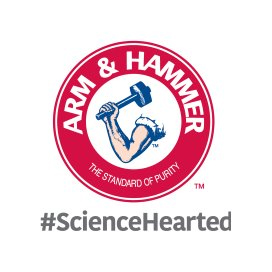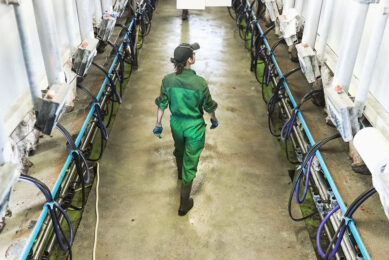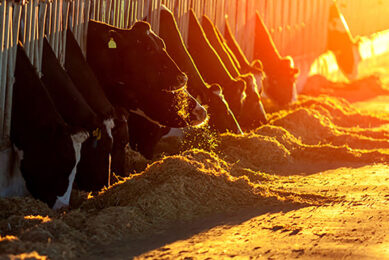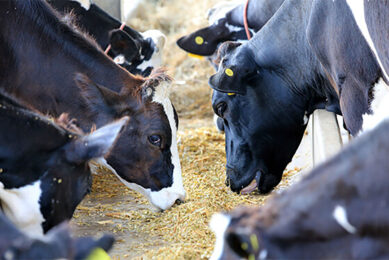Formulate prepartum dairy rations to the proper DCAD level
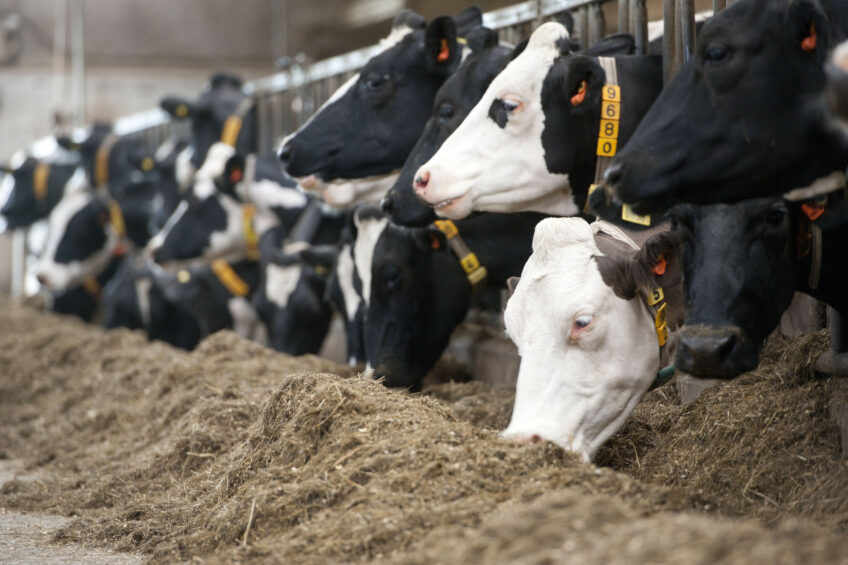
Feeding a ration with negative dietary cation-anion difference (DCAD) of -8 to -12 meg/100g ration dry matter for the last 3 weeks prior to calving is an excellent strategy to help cows get off to a good start after calving.
Negative DCAD helps to mobilise calcium transfer from bones to the cow’s bloodstream. This wards off a rapid decline in blood calcium around calving, which is associated with clinical – and subclinical – hypocalcemia (milk fever).
In particular, cows with hypocalcemia often experience a depressed immune response and are also susceptible to reduced skeletal and smooth muscle function. This predisposes cows to displaced abomasum, mastitis and a host of other challenges including poor uterine involution, metritis and ovarian dysfunction. Further, healthier cows produce more milk than those that must deal with these transition period health challenges.
Positive results from supplement inclusion
Results from a study published in the November 2010 Journal of Dairy Science, indicate that when the product Bio-Chlor was included in the ration to lower prepartum DCAD levels, cows produced substantially more milk per day than cows not fed a ration formulated for negative DCAD prior to calving (Figure 1).
During the study, researchers also monitored blood β-hydroxybutyrate (BHBA) levels for mature cows and first-lactation cows. On a herd level, BHBA is a useful indicator of the ability of cows to deal with metabolic challenges in the transition period. For individual cows, increased serum concentrations of BHBA around calving have been associated with lower milk production and impaired early reproduction.
They found that postpartum BHBA was lower for both first-lactation and mature cows fed rations formulated for negative DCAD compared with the control diet.
Don’t go too low
But keep in mind that when formulating for ration DCAD, lower is not necessarily better. Research conducted at the University of Florida has found that it’s not necessary to reduce ration DCAD levels in prepartum diets beyond -12.
That study shows that pushing DCAD levels below -12 did not show any positive effects on cow health and performance, meaning it only becomes an added expense. During the study, the researchers fed prefresh Holstein dairy cows a ration with a negative DCAD of either -7 meq/100g ration DM or -18 meq/100g ration DM for either the last 21 days or 42 days of gestation.
Adverse effects on performance
They found that feeding a more negative DCAD diet – regardless of duration – adversely affected key metabolic and performance parameters of blood base excess and dry matter intake. Specifically, data showed that reducing the level of negative DCAD from −7 to −18 meq/100g ration DM:
• Reduced prepartum dry matter intake by 1.4 to 2.2 kilograms per day
• Induced a more exacerbated metabolic acidosis prepartum
“The negative DCAD diet reduced dry matter intake prepartum as expected,” explains Dr José Santos, research foundation professor, University of Florida Department of Animal Sciences. “That is an anticipated response based on all the literature available.”
Ultimately, the data suggest that there is no apparent reason why you should feed a negative DCAD diet more than -12 meq/100g ration DM and DCAD of -8 to -10 appear to do the same job.
Does timing matter?
This research also reinforces previous studies that show that dairies can feed negative-DCAD diets longer than 21 days without any negative effects. No differences in energy corrected or fat corrected milk was observed in the cows fed the negative DCAD diet for the 42-day dry period.
In the long run, all cows benefited from the negative-DCAD diet, regardless of how long it was fed. The data offer compelling evidence that dairies that are unable to group cows separately or feed multiple rations during the dry period can still benefit from a negative-DCAD ration.
Author: Dr Elliot Block, senior research fellow & director of technology, Arm & Hammer Animal Nutrition
References available upon request.
Join 13,000+ subscribers
Subscribe to our newsletter to stay updated about all the need-to-know content in the dairy sector, two times a week.


